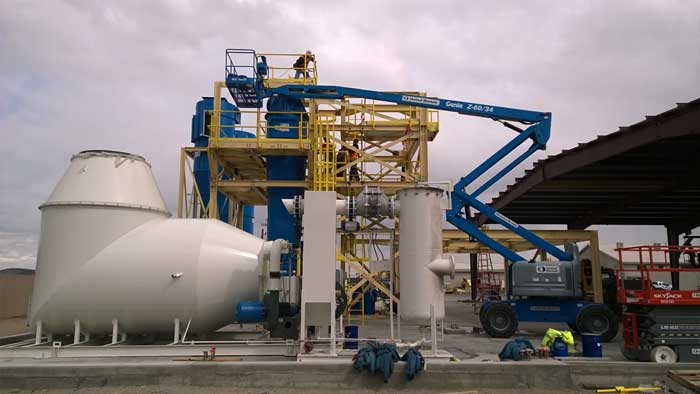When electric-carmaker Tesla Motors (NASDAQ: TSLA) announced on Feb. 26 that it would build the world’s largest lithium-ion battery factory in the U.S., Western Lithium (TSX: WLC; US-OTC: WLCDF) surged 36% to 72¢ per share, with nearly 4 million shares changing hands.
The excitement generated by the proposed $5-billion “gigafactory,” which the carmaker says should push down the cost of its battery pack (per kWH) by more than 30%, drove Western Lithium’s shares even higher the next day — accelerating another 18% to 85¢, on another 5 million shares traded.
Tesla — based in Palo Alto, Calif., and headed by billionaire Elon Musk — said it is exploring locations for the planned 10-million-square-foot facility in Texas, Nevada, Arizona and New Mexico. The plant will be key to its goal of becoming a mass-market electric carmaker. It expects production at the battery plant by 2020.
Tesla’s plans dovetail nicely with Western Lithium’s schedule for advancing its Kings Valley lithium project in Nevada, 100 km northwest of Winnemucca.
Permitting would take three years and the lithium plant would start up in 2018–2019, estimates Jay Chmelauskas, Western Lithium’s Vancouver-based president and CEO.
The lithium in hectorite clay project is estimated to have a 20-year mine life based on proven and probable reserves of 27.14 million tonnes grading 0.395% lithium (or 570,000 tonnes of lithium carbonate equivalent), according to a prefeasibility study. At full capacity the mine and processing facility should produce 26,000 tonnes of lithium carbonate per year.
“It’s sizable,” Chmelauskas says. “Based on our historical ranking we’re the fifth-largest lithium deposit in the world.”
Once in production, Kings Valley would make the U.S. a third hub for lithium production after South America and Australia, he says. Currently 70% of the world’s lithium comes from two geological deposits in South America (mined by three different companies) and the other 30% comes from one geological deposit in Australia, Chmelauskas explains.
“That’s a concentrated supply source for lithium in a market that is growing and is important to the automotive industry,” he says. “So we’ve always thought diversification of lithium is warranted and we could make Nevada a new hub for lithium supply.”
If that happens, he adds, the state will benefit by capturing “the technology and innovation and invention that comes from those molecules in the form of new and improved cathode powders, chemistries and battery technology.”
Western Lithium is building a demonstration plant in Germany that should be up and running by year-end. Chmelauskas says the plant will show that the company can produce lithium carbonate from clay. If it does, it will be the first company to do so, and have a patent on the process.
“We’re going to invite the whole world to see this thing so that they can choose us as the next investment for lithium,” he says.
In the meantime, Western Lithium plans to generate cash flow later this year from the Kings Valley deposit by producing hectatone, a product used in the oil and gas industry. Hectatone products provide viscosity, lubrication and sealing properties for drilling fluid and are mostly used in deep fracking operations. Western Lithium will mine the clay at Kings Valley and truck it 322 km to Fernley, where it is building an organoclay manufacturing plant.
In March, the hectorite clay project got its environmental assessment approval from the Nevada office of the Bureau of Land Management, which said it found no significant impacts from the project. Chmelauskas expects the company will receive the last permit it needs — called the plan of operations — in time to mine in April or May. The processing plant in Fernley could be finished by September.
“We made a decision to focus on the hectatone business a year and a half ago when we started the permitting process, with the idea that we could generate cash flow from a small business attached to the global drilling industry and get that up and running . . . and grow that business at the same time as the market was warming up to electric cars and lithium,” Chmelauskas explains.
David Talbot of Dundee Capital Markets, who initiated coverage of the company on March 31, estimates that the market in North America for drilling mud is 50,000 tonnes per year, and says Western Lithium expects to supply 10,000 tonnes.
The analyst also says the company offers “a unique opportunity” for shareholders to get both near-term cash flow from organoclay sales and mid-term lithium production, two sectors that both demonstrate strong fundamentals in his opinion.
Of course lithium production is the company’s much larger business, and if Tesla’s battery plant goes ahead, it would bring with it significant demand for lithium carbonate.
“Kings Valley would be one of only two integrated production facilities in the U.S. — the other being Rockwood’s Silver Peak mine, which produces only perhaps 5,000 to 10,000 tonnes of LCE [no public data],” Talbot writes in a research report, adding that by contrast Kings Valley has potential for 26,000 tonnes per year of lithium carbonate.
“Early projections suggest Tesla could demand upwards of 40,000 to 50,000 tonnes of lithium carbonate, the equivalent of current world battery demand,” Talbot continues. “Let’s not forget projections of 7–9% CAGR in the lithium-sector event without Tesla’s demand influence.”
The Kings Valley deposit is located within the McDermitt Caledra complex, a well-preserved volcanic feature in north-central Nevada and southeastern Oregon. The deposit was found in 1977 by Chevron Resources when it was looking for uranium.
Power lines run 0.5 km south of the project.
Over the last year Western Lithium has traded within a range of 12¢ and 95¢ per share. At press time it traded at 80¢. The company has 102 million shares outstanding.


Wondering about the economics supporting a 200 mile truck haul of “ore”
from the mine operation to the plant at Fernley. . .
And proof reading of the news item would have caught the caledra (sic)
glitch.